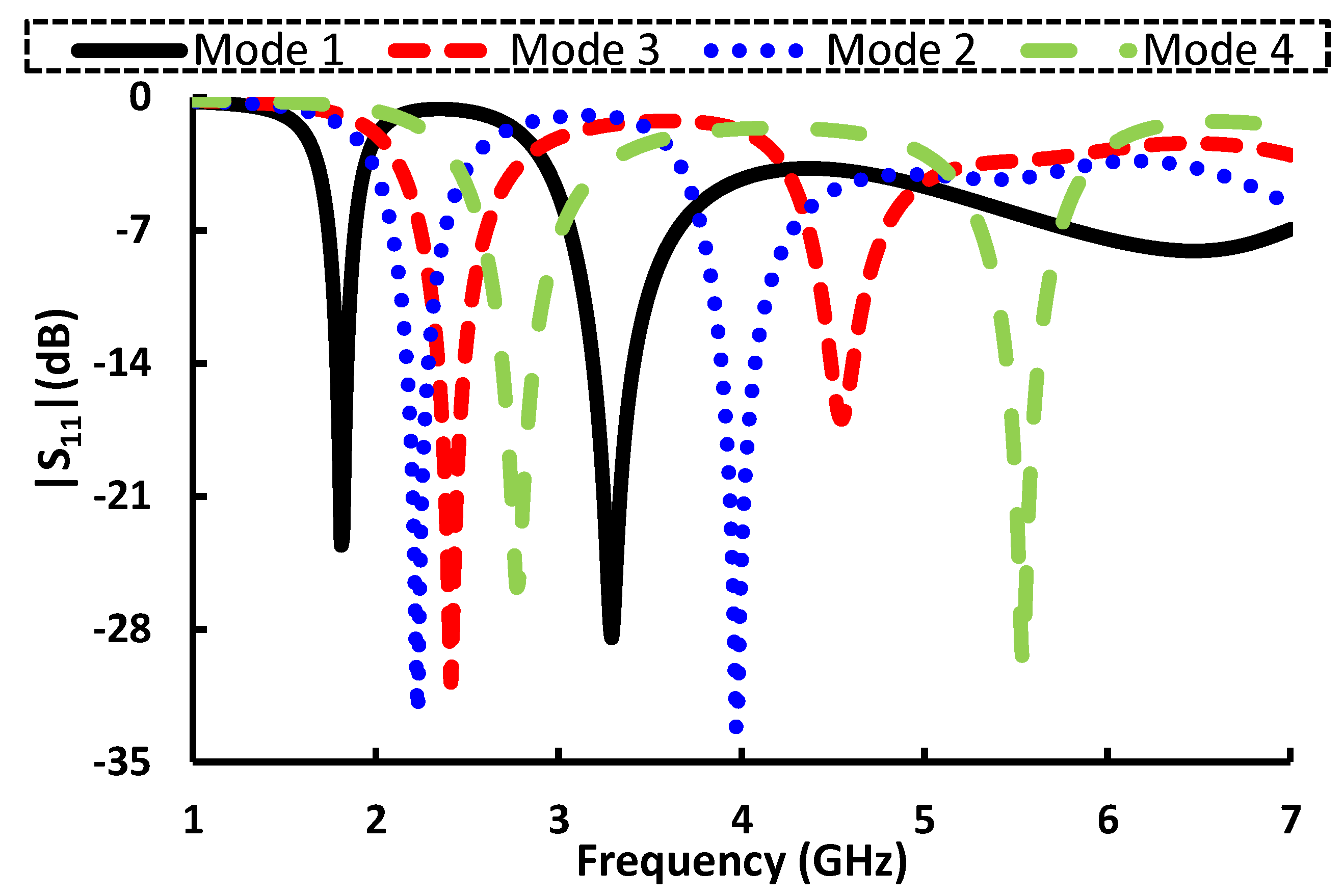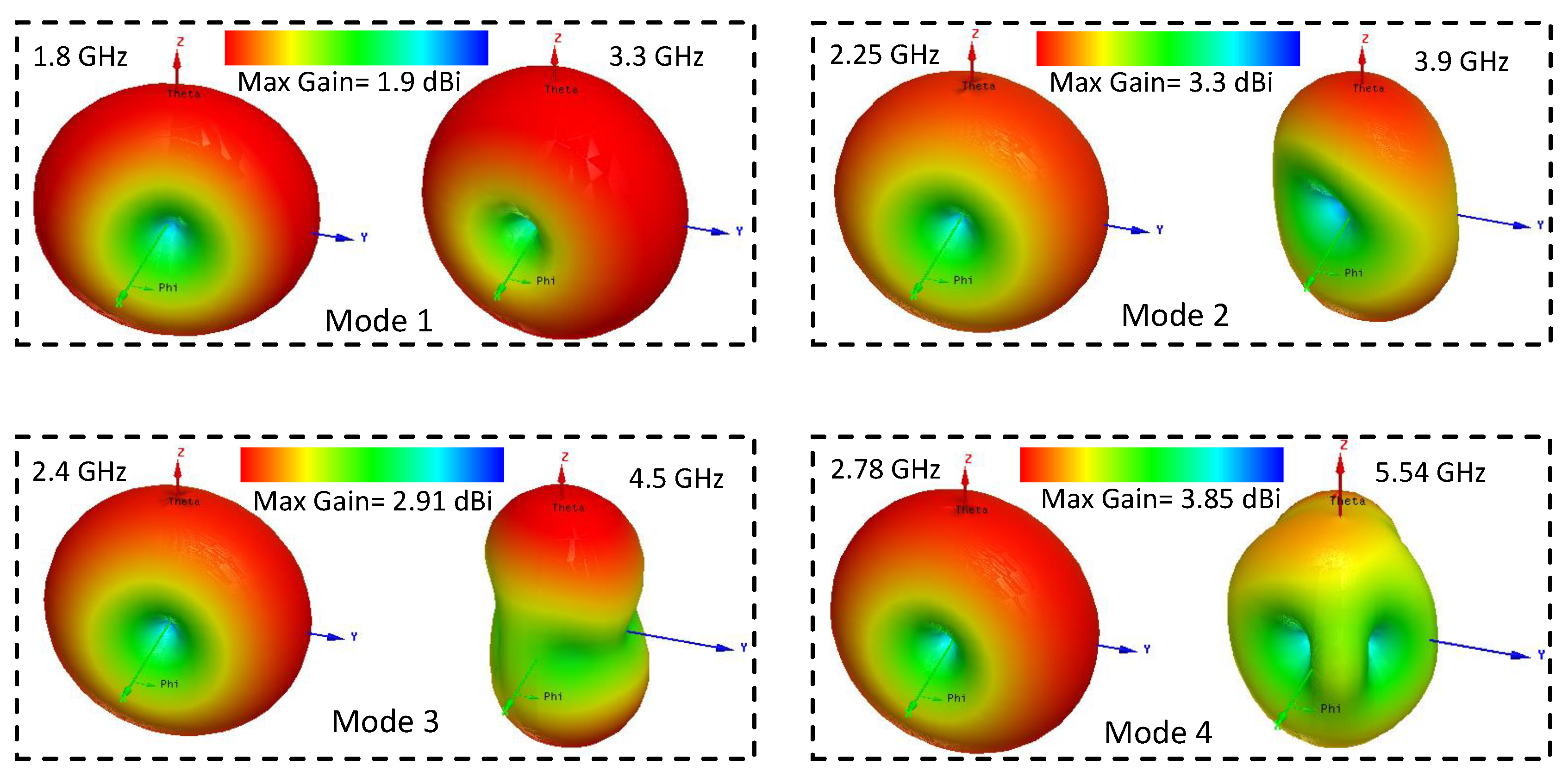Low-Profile Frequency Reconfigurable Antenna for Heterogeneous Wireless Systems
Abstract
:1. Introduction
2. Antenna Design Methodology
2.1. Frequency Reconfigurability
2.2. Switching Technique
3. Results and Discussions
3.1. Reflection Coefficient
3.2. Surface Current Distribution
3.3. Gain and Efficiency
3.4. Radiation Pattern
3.5. Specific Absorption Rate Analysis
4. Conclusions
Author Contributions
Funding
Conflicts of Interest
References
- Elfergani, I.; Hussaini, A.S.; Rodriguez, J.; Abd-Alhameed, R. Antenna Fundamentals for Legacy Mobile Applications and Beyond; Springer: Bolingbrook, IL, USA, 2018. [Google Scholar]
- Kunwar, A.; Gautam, A.K. Fork-shaped planar antenna for Bluetooth, WLAN, and WiMAX applications. Int. J. Microw. Wirel. Technol. 2017, 9, 859–864. [Google Scholar] [CrossRef]
- Kunwar, A.; Gautam, A.K.; Kanaujia, B.K. Inverted L-slot triple-band antenna with defected ground structure for WLAN and WiMAX applications. Int. J. Microw. Wirel. Technol. 2017, 9, 191–196. [Google Scholar] [CrossRef]
- Iqbal, A.; Saraereh, O.A. A compact frequency reconfigurable monopole antenna for Wi-Fi/WLAN applications. Prog. Electromagnet. Res. 2017, 68, 79–84. [Google Scholar]
- Iqbal, A.; Ullah, S.; Naeem, U.; Basir, A.; Ali, U. Design, fabrication and measurement of a compact, frequency reconfigurable, modified T-shape planar antenna for portable applications. J. Electr. Eng. Technol. 2017, 12, 1611–1618. [Google Scholar]
- Lee, S.; Sung, Y. Compact frequency reconfigurable antenna for LTE/WWAN mobile handset applications. IEEE Trans. Antennas Propag. 2015, 63, 4572–4577. [Google Scholar] [CrossRef]
- Ali, T.; Biradar, R.C. A compact hexagonal slot dual band frequency reconfigurable antenna for WLAN applications. Microw. Opt. Technol. Lett. 2017, 59, 958–964. [Google Scholar] [CrossRef]
- Ullah, S.; Hayat, S.; Umar, A.; Ali, U.; Tahir, F.A.; Flint, J.A. Design, fabrication and measurement of triple band frequency reconfigurable antennas for portable wireless communications. AEU-Int. J. Electron. Commun. 2017, 81, 236–242. [Google Scholar] [CrossRef]
- Khan, O.M.; Raza, K.; Shubair, R.; Islam, Q.U. Frequency Reconfigurable Implant Antenna for MICS and ISM Band Applications. In Proceedings of the 18th International Symposium on Antenna Technology and Applied Electromagnetics (ANTEM). IEEE, Waterloo, ON, Canada, 19–22 August 2018; pp. 1–2. [Google Scholar]
- Ruvio, G.; Ammann, M.J.; Chen, Z.N. Wideband reconfigurable rolled planar monopole antenna. IEEE Trans. Antennas Propag. 2007, 55, 1760–1767. [Google Scholar] [CrossRef]
- Bharathi, A.; Lakshminarayana, M.; Rao, P.S. A quad-polarization and frequency reconfigurable square ring slot loaded microstrip patch antenna for WLAN applications. AEU-Int. J. Electron. Commun. 2017, 78, 15–23. [Google Scholar] [CrossRef]
- Shah, S.A.A.; Khan, M.F.; Ullah, S.; Basir, A.; Ali, U.; Naeem, U. Design and Measurement of Planar Monopole Antennas for Multi-Band Wireless Applications. IETE J. Res. 2017, 63, 194–204. [Google Scholar] [CrossRef]
- Jin, G.P.; Deng, C.H.; Yang, J.; Xu, Y.C.; Liao, S.W. A New Differentially-Fed Frequency Reconfigurable Antenna for WLAN and Sub-6GHz 5G Applications. IEEE Access 2019. [Google Scholar] [CrossRef]
- Hu, P.F.; Pan, Y.M.; Zhang, X.Y.; Hu, B.J. A Filtering Patch Antenna With Reconfigurable Frequency and Bandwidth Using F-Shaped Probe. IEEE Trans. Antennas Propag. 2019, 67, 121–130. [Google Scholar] [CrossRef]
- Shah, I.; Hayat, S.; Basir, A.; Zada, M.; Shah, S.; Ullah, S. Design and analysis of a hexa-band frequency reconfigurable antenna for wireless communication. AEU-Int. J. Electron. Commun. 2019, 98, 80–88. [Google Scholar] [CrossRef]
- Ullah, S.; Ahmad, S.; Khan, B.; Ali, U.; Tahir, F.; Bashir, S. Design and Analysis of a Hexa-Band Frequency Reconfigurable Monopole Antenna. IETE J. Res. 2018, 64, 59–66. [Google Scholar] [CrossRef]
- Ullah, S.; Ahmad, S.; Khan, B.A.; Flint, J.A. A multi-band switchable antenna for Wi-Fi, 3G Advanced, WiMAX, and WLAN wireless applications. Int. J. Microw. Wirel. Technol. 2018, 10, 991–997. [Google Scholar] [CrossRef]
- Singh, A.; Goode, I.; Saavedra, C.E. A Multi-State Frequency Reconfigurable Monopole Antenna using Fluidic Channels. IEEE Antennas Wirel. Propag. Lett. 2019. [Google Scholar] [CrossRef]
- Balanis, C.A. Antenna Theory: Analysis and Design; John wiley & sons: Hoboken, NJ, USA, 2016. [Google Scholar]
- Iqbal, A.; Smida, A.; Mallat, N.K.; Ghayoula, R.; Elfergani, I.; Rodriguez, J.; Kim, S. Frequency and pattern reconfigurable antenna for emerging wireless communication systems. Electronics 2019, 8, 407. [Google Scholar] [CrossRef]
- Bouazizi, A.; Zaibi, G.; Iqbal, A.; Basir, A.; Samet, M.; Kachouri, A. A dual-band case-printed planar inverted-F antenna design with independent resonance control for wearable short range telemetric systems. Int. J. RF Microw. Comput.-Aided Eng. 2019, 29, e21781. [Google Scholar] [CrossRef]
- Basir, A.; Bouazizi, A.; Zada, M.; Iqbal, A.; Ullah, S.; Naeem, U. A dual-band implantable antenna with wide-band characteristics at MICS and ISM bands. Microw. Opt. Technol. Lett 2018, 60, 2944–2949. [Google Scholar] [CrossRef]
- Iqbal, A.; Basir, A.; Smida, A.; Mallat, N.K.; Elfergani, I.; Rodriguez, J.; Kim, S. Electromagnetic Bandgap Backed Millimeter-Wave MIMO Antenna for Wearable Applications. IEEE Access 2019, 7, 111135–111140. [Google Scholar] [CrossRef]









| Resonant Bands | ||||
|---|---|---|---|---|
| Mode 1 | ON | ON | ON | 1.8 and 3.3 GHz |
| Mode 2 | ON | ON | OFF | 2.25 and 3.9 GHz |
| Mode 3 | ON | OFF | OFF | 2.4 and 4.5 GHz |
| Mode 4 | OFF | OFF | OFF | 2.78 and 5.54 GHz |
| Parameters | Mode 1 | Mode 2 | Mode 3 | Mode 4 | ||||
|---|---|---|---|---|---|---|---|---|
| Frequencies (GHz) | 1.8 | 3.3 | 2.25 | 3.9 | 2.4 | 4.5 | 2.78 | 5.54 |
| Bandwidth (MHz) | 120 | 390 | 200 | 320 | 250 | 270 | 310 | 320 |
| VSWR | 1.13 | 1.06 | 1.04 | 1.04 | 1.05 | 1.43 | 1.09 | 1.05 |
| Gain (dBi) | >1.5 | >1.76 | >3.16 | >3.22 | >2.89 | >2.75 | >3.5 | >3.79 |
| Efficiency (%) | >83 | >82 | >88 | >88 | >88 | >87 | >88.3 | >87 |
| Peak SAR (W/kg) | 9.37 | 7.4 | 8.99 | 7.11 | 7.93 | 5.33 | 5.98 | 4.7 |
| Ref. [] | Size × × | No. of Switches | No. of Bands | Operational Bands | Gain (dBi) | Efficiency (%) |
|---|---|---|---|---|---|---|
| [4] | 0.62 × 0.65 × 0.02 | 1 PIN diode | 3 | (1.8–2.7 GHz), (2.49–3.84 GHz), (5.26–5.99 GHz) | NG | NG |
| [5] | 0.62 × 0.65 × 0.02 | 1 PIN Diode | 3 | (2.06–3.14 GHz), (2.44–3.66 GHz), (5.11–5.66 GHz) | >1.2 | >90 |
| [6] | 0.24 × 0.59 × 0.02 | 2 PIN diodes | 8 | (698–787 MHz), (2305–2400 MHz), (2500-2690 MHz), (824–894 MHz), (880–960 MHz), (1710–1880 MHz), (1850–1990 MHz), (1920–2170 MHz) | 0.13–1.59 | 52.83–75.6 |
| [7] | 0.21 × 0.12 × 0.02 | 2 PIN diodes | 4 | (2.31–2.62 GHz), (5.13–5.32 GHz), (2.32–2.61 GHz), (5.12–5.33 GHz) | 2.91–3.13 | NG |
| [8] | 0.58 × 0.88 × 0.02 | 1 PIN diode | 3 | 3.5 %, 35.72 %, and 9.94 % | 1.7–3.4 | 85–90 |
| [12] | 0.33 × 0.67 × 0.02 | 1 PIN diode | 4 | 36 %, 15 %, 31 % and 22 % | 1.76–2.91 | 76.43–84.2 |
| [13] | 1.68 × 1.68 × 0.09 | 2 PIN diodes | 2 | (2.37–2.67 GHz), (3.39–3.62 GHz) | 6.51, 7.64 | 64.5, 69.5 |
| [15] | 0.22 × 0.46 × 0.02 | 3 PIN diodes | 6 | 9.35, 13.2, 21.49, 11.71, 41.5 and 9.35% | 1.85–3.46 | 80.41–96.75 |
| [16] | 0.58 × 0.67 × 0.02 | 2 PIN diodes | 6 | 430, 1090, 1045, 2210, 1125, and 847 MHz | 2.18–4.46 | 90–97 |
| [17] | 0.58 × 0.67 × 0.02 | 2 PIN diodes | 6 | 1220, 335, 512, 1020, 486, and 463 MHz | 2.20–4.01 | 92.5–97 |
| This Work | 0.21 × 0.35 × 0.02 | 3 PIN diodes | 8 | (1.76–1.88 GHz), (3.12–3.51 GHz), (2.13–2.33 GHz), (3.84–4.16 GHz), (2.29–2.54 GHz), (4.43–4.7 GHz), (2.63–2.94 GHz), (5.37–5.69 GHz) | 1.5–3.85 | 82–89 |
© 2019 by the authors. Licensee MDPI, Basel, Switzerland. This article is an open access article distributed under the terms and conditions of the Creative Commons Attribution (CC BY) license (http://creativecommons.org/licenses/by/4.0/).
Share and Cite
Iqbal, A.; Smida, A.; Abdulrazak, L.F.; Saraereh, O.A.; Mallat, N.K.; Elfergani, I.; Kim, S. Low-Profile Frequency Reconfigurable Antenna for Heterogeneous Wireless Systems. Electronics 2019, 8, 976. https://doi.org/10.3390/electronics8090976
Iqbal A, Smida A, Abdulrazak LF, Saraereh OA, Mallat NK, Elfergani I, Kim S. Low-Profile Frequency Reconfigurable Antenna for Heterogeneous Wireless Systems. Electronics. 2019; 8(9):976. https://doi.org/10.3390/electronics8090976
Chicago/Turabian StyleIqbal, Amjad, Amor Smida, Lway Faisal Abdulrazak, Omar A. Saraereh, Nazih Khaddaj Mallat, Issa Elfergani, and Sunghwan Kim. 2019. "Low-Profile Frequency Reconfigurable Antenna for Heterogeneous Wireless Systems" Electronics 8, no. 9: 976. https://doi.org/10.3390/electronics8090976
APA StyleIqbal, A., Smida, A., Abdulrazak, L. F., Saraereh, O. A., Mallat, N. K., Elfergani, I., & Kim, S. (2019). Low-Profile Frequency Reconfigurable Antenna for Heterogeneous Wireless Systems. Electronics, 8(9), 976. https://doi.org/10.3390/electronics8090976








